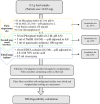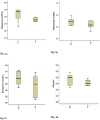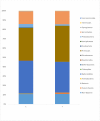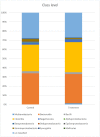Dietary multi-enzyme complex improves In Vitro nutrient digestibility and hind gut microbial fermentation of pigs
- PMID: 31136616
- PMCID: PMC6538249
- DOI: 10.1371/journal.pone.0217459
Dietary multi-enzyme complex improves In Vitro nutrient digestibility and hind gut microbial fermentation of pigs
Abstract
This study was conducted in two stages to investigate the potential of multi-enzyme supplementation on the nutrient digestibility, growth performance, and gut microbial composition of pigs. In stage 1, effects of multi-enzyme complex (xylanase, α-amylase, β-glucanase, and protease) supplementation on the ileal and total tract dry matter (DM) digestibility of feed-stuffs were investigated with in vitro two-stage and three-stage enzyme incubation methods. A wide range of feed ingredients, namely, corn meal, wheat meal, soybean meal, fish meal, Oriental herbal extract, Italian rye-grass (IRG) and peanut hull were used as substrates. Supplementation of the multi-enzyme complex increased (P < 0.05) the digestibility of the Oriental herbal extract and corn meal. In stage 2, in vivo animal studies were performed to further investigate the effects of the dietary multi-enzyme complex on the nutrient utilization, growth performance, and fecal microbial composition of pigs. A total of 36 weaned pigs were fed corn- and soybean meal-based diets without (control) and with the multi-enzyme complex (treatment) for 6 weeks. Fecal samples were collected from 12 pigs to analyze the microbial communities by using DNA sequencing and bioinformatics tools. Multi-enzyme supplementation had no effect on apparent digestibility of nutrients and growth performance of pigs compared to control. Taxonomic analysis of the fecal samples indicated that the bacteria in both control and treatment samples predominantly belonged to Firmicutes and Bacteroidetes. In addition, the proportion of the phylum Firmicutes was slightly higher in the treatment group. At the genus level, the abundance of Treponema and Barnesiella increased in the treatment group; whereas the numbers ofthe genera including Prevotella, Butyricicoccus, Ruminococcus and Succinivibrio decreased in the treatment group. These results suggest that multi-enzyme supplementation with basal diets have the potential to improve nutrient digestibility and modify microbial communities in the hind-gut of pigs.
Conflict of interest statement
The authors have declared that no competing interests exist.
Figures






Similar articles
-
Efficacy of a novel multi-enzyme feed additive on growth performance, nutrient digestibility, and gut microbiome of weanling pigs fed corn-wheat or wheat-barley-based diet.J Anim Sci. 2024 Jan 3;102:skae064. doi: 10.1093/jas/skae064. J Anim Sci. 2024. PMID: 38466229 Free PMC article.
-
Growth performance, nutrient digestibility, and fecal microbial composition of weaned pigs fed multi-enzyme supplemented diets.J Anim Sci. 2020 Oct 1;98(10):skaa306. doi: 10.1093/jas/skaa306. J Anim Sci. 2020. PMID: 32918072 Free PMC article.
-
Growth performance, gastrointestinal microbial activity, and nutrient digestibility in early-weaned pigs fed diets containing flaxseed and carbohydrase enzyme.J Anim Sci. 2007 Nov;85(11):2982-93. doi: 10.2527/jas.2006-481. Epub 2007 Aug 8. J Anim Sci. 2007. PMID: 17686904
-
In-vitro digestion models: a critical review for human and fish and a protocol for in-vitro digestion in fish.Bioengineered. 2021 Dec;12(1):3040-3064. doi: 10.1080/21655979.2021.1940769. Bioengineered. 2021. PMID: 34187302 Free PMC article. Review.
-
Organic Acids Mixture as a Dietary Additive for Pigs-A Review.Animals (Basel). 2020 May 30;10(6):952. doi: 10.3390/ani10060952. Animals (Basel). 2020. PMID: 32486180 Free PMC article. Review.
Cited by
-
Effects of Italian ryegrass with multi-enzymes supplementation on growth performance, gut microbial, and manure odor emission in finisher pig.J Anim Sci Technol. 2024 Nov;66(6):1182-1192. doi: 10.5187/jast.2024.e23. Epub 2024 Nov 30. J Anim Sci Technol. 2024. PMID: 39691618 Free PMC article.
-
Optimizing the zymogram of exogenous proteases in broiler diets by in vitro simulated gastrointestinal digestion and response surface methodology.Sci Rep. 2025 Feb 24;15(1):6605. doi: 10.1038/s41598-025-88954-w. Sci Rep. 2025. PMID: 39994257 Free PMC article.
-
The transcriptome of the rumen ciliate Entodinium caudatum reveals some of its metabolic features.BMC Genomics. 2019 Dec 21;20(1):1008. doi: 10.1186/s12864-019-6382-x. BMC Genomics. 2019. PMID: 31864285 Free PMC article.
-
A systematic-review on the role of exogenous enzymes on the productive performance at weaning, growing and finishing in pigs.Vet Anim Sci. 2021 Aug 18;14:100195. doi: 10.1016/j.vas.2021.100195. eCollection 2021 Dec. Vet Anim Sci. 2021. PMID: 34522821 Free PMC article. Review.
-
Modulation of digestibility of canine food using enzyme supplement: an in vitro simulated semi-dynamic digestion study.Front Vet Sci. 2023 Aug 9;10:1220198. doi: 10.3389/fvets.2023.1220198. eCollection 2023. Front Vet Sci. 2023. PMID: 37621870 Free PMC article.
References
-
- Choct M. Feed non-starch polysaccharides: chemical structures and nutritional significance. Feed Milling International.1997;191: 13–26.
-
- Choct M, Dersjant-Li Y, McLeish J, Peisker M. Soy oligosaccharides and soluble non-starch polysaccharides: a review of digestion, nutritive and anti-nutritive effects in pigs and poultry. Asian Austal J Anim. 2010;23: 1386–1398.
Publication types
MeSH terms
Substances
LinkOut - more resources
Full Text Sources
Medical

